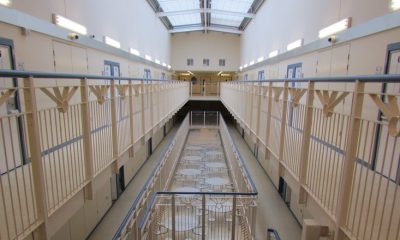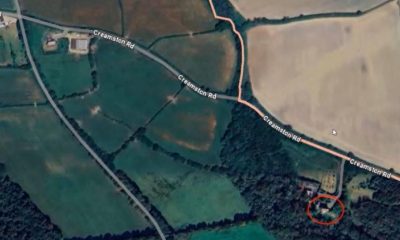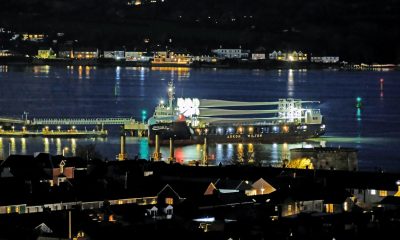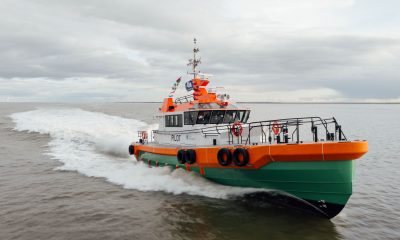News
How Pembrokeshire’s beaches were used as practice for the world’s biggest invasion

By Jon Coles, Andy Chandler and Thomas Sinclair
JUNE 6 marks the anniversary of D-Day, when the Allied forces landed on the beaches of Normandy, France as part of Operation Overlord; a concerted and successful attempt to liberate Europe from the grip of German occupation under Hitler.
The invasion of Normandy (codenamed Operation Neptune) was a massive amphibious assault involving 7,000 ships and 11,000 aircraft. A decoy plan, Operation Fortitude, led the Germans to believe the main target was Pas de Calais. It was a major milestone in securing victory for the allied forces.
Tenby, Saundersfoot, Amroth and Laugharne had already experienced their own version of the Normandy landings – in practice form.
Our local beaches were the location for an extensive two-week-long practice, Operation Jantzen. The exercise commenced on July 22, 1943, and was, thankfully, the only land invasion of Wales during World War II.
Under the watchful eyes of Winston Churchill and Lord Mountbatten (rumour has it that Eisenhower also attended), 100,000 American, Australian, British and Canadian forces had a rare opportunity to practice every element needed for a successful attack on “Fortress Europe”, this involved the initial landings, the setting up of Headquarters and even the moving and stockpiling of vital supplies that would be needed by troops on the front line.
Newsreel footage clearly shows trucks somehow being driven onto flat-bottomed transports in preparation for the training excercise on Tenby Beach, a beach more commonly associated with bathing, swimming and making sandcastles.

THE TROOPS
The Regimental War Chronicles of the Oxfordshire & Buckinghamshire Light Infantry Vol3 1942-1944 records that the First Bucks Battalion had been training in Ayrshire before moving to West Wales.
The road convoy of over 200 vehicles left Ayr on the July 8, 1943, and the main body departed by train three days later. Troops disembarked at Haverfordwest station, where three-ton lorries lifted them to Picton Park.
Picton Park, consisting of Nissen huts and tents, provided an excellent concentration area and preparations for Exercise “Jantzen,” due to start on the July 17, were pressed forward.
All was ready, but the exercise was postponed owing to bad weather, and the move to the assembly area at Cresselly did not begin until July 20.
The area allotted to No. 6 Beach Group consisted of the village of Saundersfoot and its immediate hinterland. There were two small beaches and a tiny port, and the country behind the beaches was hilly and heavily wooded, with narrow country lanes.
No. 5 Beach Group had an equally difficult area some miles to the east with a steep, shingle bank at the head of the beach which made exits and entrances serious problems.
The first key plan prepared before the exercise needed little adjustment and the deployment of thousands of men and hundreds of vehicles and guns proceeded most smoothly.
Coasters and barges were loaded at Tenby and beached at Saundersfoot on a falling tide.
Stores were unloaded first to barge and then to lorry, and, when the coasters had dried out, direct to lorry. Folding boats were not used and the DUKW had still not made its appearance.
On August 5 (D+14) the exercise was closed.
A great many lessons had been learned from “Jantzen.” The organisation and training of the group were sound. The complicated deployment drill had worked smoothly although it had been shown how vulnerable any beach organisation is to deterioration in the weather.
The effort was not only limited to troop movements.
The first major supply exercise involving barges (36 in 3 flotillas), 36 coasters and other forces, took place at Tenby, South Wales in July/August 1943 in Exercise “Jantzen”.
As part of the preparation for sailing across the English Channel for the Normandy landings, “dumb” Thames River barges sailed from the south coast of England around Land’s End and across the Bristol Channel under their own power.
The barges acted as kitchen vessels and troop transports during the exercise.
They subsequently made even longer coastal voyages over to Normandy as supply vessels.
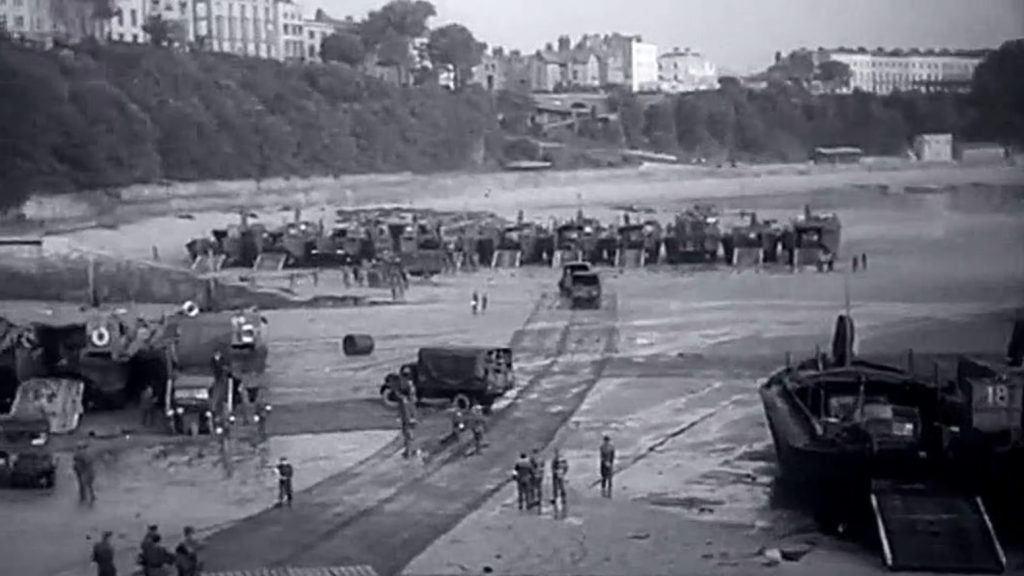
All of which begs the question: Why West Wales?
The beaches of west Wales were chosen because they mimicked the conditions of Normandy being a mixture of salt flats, shingle and wide sandy areas overlooked by dunes. In addition, earlier in the war some of them had been extensively fortified and defensive measures put in place as part of the preparations for invasion.
The importance of experiencing the ‘draft’ of landing beaches was vitally important as were the changing tidal conditions around the West Wales coast.
The area’s roads were also used to give troops experience of moving along thin, rural roads with heavy armour like Tanks and Armoured Troop Carriers.
Speaking to the BBC in 2007, Bentley Howell, whose family lived at Wiseman’s Bridge Inn at the time, remembered some of the events surrounding Operation: Jantzen.
“My half-brother, who was about 40 years old, was at the time the licensee of the Wiseman’s Bridge Inn, Permbrokeshire. In his old age, he used to tell me of his wartime memories and particularly about the day that Winston Churchill called in for a pot of tea.
“A full scale invasion landing practice took place, involving up to 100,000 men, DUKW’s, other landing craft, and troopships disgorging their loads onto the sands of the Saundersfoot bay.
“The publican, John Henry Mathias, or ‘Jack the Bridge’ as he was affectionately known, was appointed a Coastguard because of his local knowledge, and although the whole area had been sealed off for security reasons and a 10pm curfew imposed, Jack was exempt from this and wandered at will.
“Officially, the troops were not allowed to drink, but for 1s 6d they had all they could eat – home killed ham, eggs, fried bread and apple tart. Jack entertained them with tales of a ghostly monk who roamed the tunnels between Saundersfoot and Wiseman’s Bridge.
“One day, several large staff cars swept down the narrow lane to the pub. It was about 3pm, but in those days the pub was open all hours. A blonde woman in an ATS uniform carried out ‘a plain Welsh tea’ to the party of about 15 high ranking officers – later it was learned that she was Sarah Churchill; Winston Churchill surveyed the troops on the beaches together with Admiral Viscount Mountbatten. It was rumoured that Eisenhower was also present”.
For several years after the War, the letter signed by Churchill, thanking the licensee for his hospitality hung on the wall in the pub premises.
In fact, the rumours about Eisenhower’s presence in Pembrokeshire were true, but not quite in the way supposed.
The late and much-missed Vernon Scott wrote in his book An Experience Shared: “Had residents been told on the first day of the fourth month of 1944 that the Supreme Allied Commander, General Dwight D Eisenhower, was in Pembroke Dock, they would have surely dismissed it as an April Fool leg pull. But America’s top soldier in the European Theatre of Operations, really was in the area.”
Eisenhower came to west Wales to inspect the men of the 110th Infantry Regiment, at that time based at Llanion Barracks in Pembroke Dock.
By April 1944, the Regiment was going through last-minute training for the Normandy landings and push for victory.
The Supreme Commander Allied Forces’ visit came as a surprise to the GIs stationed in the County. ‘Ike’ arrived in secrecy at Tenby and was whisked to Pembroke Dock in a staff car kitted out with miniature stars and stripes for the occasion.
The GIs called Pembroke Dock ‘Blitz Ville’, surprised at the extent of the bomb damage in such a small town on the far fringes of Wales.
Pembrokeshire wears its battle-scars proudly, from the huge castles built hundreds of years ago to suppress the native Welsh, to the fuel depots, RAF airfields and anti-aircraft gun bases that were literally thrown up around the county to help protect Great Britain from the power of the Nazi war machine.
The south of the county bore the brunt of Hitler’s wrath. On August 19, 1940, a fuel depot at Llanreath, Pembroke Dock, was bombed by the Luftwaffe. The resulting fire spewed thick, black, oily smoke into the blue skies of Pembrokeshire for 18 days.
The dense plume of smoke could be seen from as far away as the North Devon coast and the fire claimed the lives of 5 Cardiff-based firemen who had been sent down to help deal with the raging inferno as an estimated 100,000 gallons of oil burned.
600 German prisoners of war were also imprisoned in Pembrokeshire during the conflict, with many being placed at local farms to plough, plant and help the Allied war effort ‘dig for victory’.
Looking around today, it’s hard to imagine the full military might of the Allies being put through their paces on our beaches, but our county’s role as a staging area for the biggest naval landing in human history cannot be underestimated
Crime
Swansea man dies weeks after release from troubled HMP Parc: Investigation launched

A SWANSEA man has died just weeks after being released from HMP Parc, the Bridgend prison now at the centre of a national crisis over inmate deaths and post-release failures.
Darren Thomas, aged 52, died on 13 November 2025 — less than a month after leaving custody. The Prisons and Probation Ombudsman (PPO) has confirmed an independent investigation into his death, which is currently listed as “in progress”.
Born on 9 April 1973, Mr Thomas had been under post-release supervision following a period at HMP/YOI Parc, the G4S-run prison that recorded seventeen deaths in custody in 2024 — the highest in the UK.
His last known legal appearance was at Swansea Crown Court in October 2024, where he stood trial accused of making a threatening phone call and two counts of criminal damage. During the hearing, reported by The Pembrokeshire Herald at the time, the court heard he made threats during a heated call on 5 October 2023.
Mr Thomas denied the allegations but was found guilty on all counts. He was sentenced to a custodial term, which led to his imprisonment at HMP Parc.
Parc: A prison in breakdown
HMP Parc has faced sustained criticism throughout 2024 and 2025. A damning unannounced inspection in January found:
- Severe self-harm incidents up 190%
- Violence against staff up 109%
- Synthetic drugs “easily accessible” across wings
- Overcrowding at 108% capacity
In the first three months of 2024 alone, ten men died at Parc — part of a wider cluster of twenty PPO-investigated deaths since 2022. Six occurred within three weeks, all linked to synthetic drug use.
Leaked staff messages in 2025 exposed a culture of indifference, including one officer writing: “Let’s push him to go tomorrow so we can drop him.”
Six G4S employees have been arrested since 2023 in connection with alleged assaults and misconduct.
The danger after release
Deaths shortly after release from custody are a growing national concern. Ministry of Justice data shows 620 people died while under community supervision in 2024–2025, with 62 deaths occurring within 14 days of release.
Short sentences — common at Parc — leave little time for effective rehabilitation or release planning. Homelessness, loss of drug tolerance and untreated mental-health conditions create a high-risk environment for those newly released.
The PPO investigates all such deaths to determine whether prisons or probation failed in their duties. Reports often take 6–12 months and can lead to recommendations.
A system at breaking point
The crisis at Parc reflects wider failures across UK prisons and probation. A July 2025 House of Lords report described the service as “not fit for purpose”. More than 500 people die in custody annually, with campaigners warning that private prisons such as Parc prioritise cost-cutting over care.
The PPO investigation into the death of Darren Thomas continues.
Crime
Woman stabbed partner in Haverfordwest before handing herself in

A WOMAN who stabbed her partner during a drug-fuelled episode walked straight into Haverfordwest Police Station and told officers what she had done, Swansea Crown Court has heard.
Amy Woolston, 22, of Dartmouth Street in Milford Haven, arrived at the station at around 8:00pm on June 13 and said: “I stabbed my ex-partner earlier… he’s alright and he let me walk off,” prosecutor Tom Scapens told the court.
The pair had taken acid together earlier in the day, and Woolston claimed she believed she could feel “stab marks in her back” before the incident.
Police find victim with four wounds
Officers went to the victim’s home to check on him. He was not there at first, but returned shortly afterwards. He appeared sober and told police: “Just a couple of things,” before pointing to injuries on his back.
He had three stab or puncture wounds to his back and another to his bicep.
The victim said that when he arrived home from the shop, Woolston was acting “a bit shifty”. After asking if she was alright, she grabbed something from the windowsill — described as either a knife or a shard of glass — and stabbed him.
He told officers he had “had worse from her before”, did not support a prosecution, and refused to go to hospital.
Defendant has long history of violence
Woolston pleaded guilty to unlawful wounding. The court heard she had amassed 20 previous convictions from 10 court appearances, including assaults, battery, and offences against emergency workers.
Defending, Dyfed Thomas said Woolston had longstanding mental health problems and had been off medication prescribed for paranoid schizophrenia at the time.
“She’s had a difficult upbringing,” he added, saying she was remorseful and now compliant with treatment.
Woolston was jailed for 12 months, but the court heard she has already served the equivalent time on remand and will be released imminently on a 12-month licence.
News
BBC apologises to Herald’s editor for inaccurate story

THE BBC has issued a formal apology and amended a six-year-old article written by BBC Wales Business Correspondent Huw Thomas after its Executive Complaints Unit ruled that the original headline and wording gave an “incorrect impression” that Herald editor Tom Sinclair was personally liable for tens of thousands of pounds in debt.

The 2019 report, originally headlined “Herald newspaper editor Tom Sinclair has £70,000 debts”, has now been changed.
The ECU found: “The wording of the article and its headline could have led readers to form the incorrect impression that the debt was Mr Sinclair’s personal responsibility… In that respect the article failed to meet the BBC’s standards of due accuracy.”
Mr Sinclair said: “I’m grateful to the ECU for the apology and for correcting the personal-liability impression that caused real harm for six years. However, the article still links the debts to ‘the group which publishes The Herald’ when in fact they related to printing companies that were dissolved two years before the Herald was founded in 2013. I have asked the BBC to add that final clarification so the record is completely accurate.”
A formal apology and correction of this kind from the BBC is extremely rare, especially for a story more than six years old.
-

 Crime2 days ago
Crime2 days agoDefendant denies using Sudocrem-covered finger to assault two-month-old baby
-

 Crime2 days ago
Crime2 days agoPembroke rape investigation dropped – one suspect now facing deportation
-

 Crime6 days ago
Crime6 days agoMan denies causing baby’s injuries as police interviews read to jury
-

 News2 days ago
News2 days agoBaby C trial: Mother breaks down in tears in the witness box
-

 Crime2 days ago
Crime2 days agoLifeboat crew member forced to stand down after being assaulted at Milford pub
-

 Crime3 days ago
Crime3 days agoDefendant denies causing injuries to two-month-old baby
-
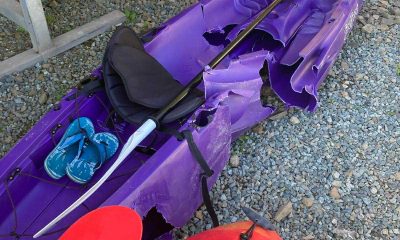
 Crime3 days ago
Crime3 days agoPembrokeshire haven master admits endangering life after speedboat collision
-

 Crime17 hours ago
Crime17 hours agoMother admits “terrible idea” to let new partner change her baby’s nappies alone







